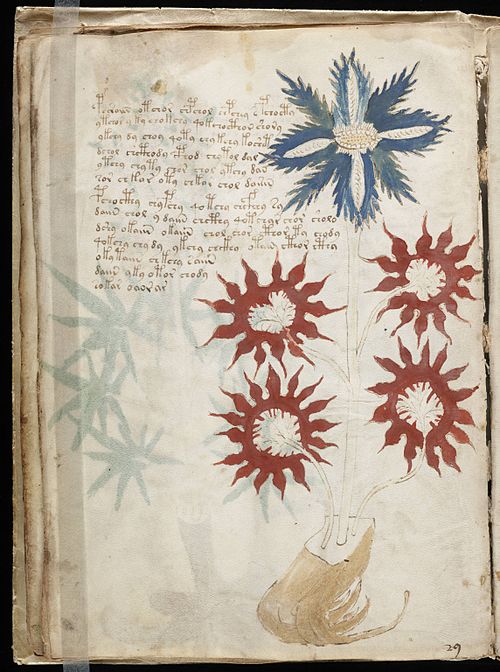
What is the Voynich manuscript? It is a 200 page, vellum codex, with hand drawn pictures. It is written in a language that no one knows or can read.
The Voynich manuscript is named after a Polish bookseller called Wilfred Voynich, who bought it in 1912. Today, the book is owned by Yale University and kept in their Rare Book and Manuscript Library. If you want to have a go at decoding it, the entire manuscript is available online. However, it has defeated some of the greatest codebreakers in history. So, good luck.
The codex is about A4 in size and it has 240 pages. It appears that some of the pages have been lost. The theory is that there were originally 272 pages. The book is handwritten on vellum, which is a type of paper made from the skin of a calf. Each page consists of writing and drawings. The writing is in a language that nobody knows and the drawings are of plants that nobody has ever seen or heard of. There are six different types of drawings. The first type appear to be plants and herbs. The second section are astronomical pictures. The third type are small, nude women, some wearing crowns, bathing in pools that are all connected by a complicated system of pipes. The fourth are diagrams of islands, some of which are connected by causeways. The fifth type are parts of plants that are probably medicinal. And the sixth part seem to be recipes. The text goes from left to right, and it is written in a semi-cursive style, with some letters connected and some not. There aren’t any mistakes in the text, which leads experts to believe that it is text copied from something else. There are slight variations in the handwriting, although they are all incredibly similar, which shows that more than one scribe worked on the book. The vellum pages have been carbon dated and they come from between 1404 and 1438.
The vellum may have come from the 15th century, but the first record of the book is in 1639, when its owner, an alchemist called Georg Baresch, tried to get help from a scholar to decipher the book. He said that it had been in his library for many years. How it came to be in his library is unknown. Baresch said the book was once bought by Rudolph II, the Holy Roman Emperor for about 2 kg of gold, but that cannot be proven. There was some question that Voynich himself forged the document by using vellum from another book, but there was no way he would have been able to get his hands on enough vellum from the same source for that to be possible.
There are 170,000 characters in the book and they appear to be divided up into words of varying length. Statistical analysis on the text has shown that it is an actual language with patterns, and not just made up nonsense. There is a lot of thought that it might be a cipher of some kind. It cannot be a simple substitution cipher because the word groups don’t break up in the right way for that. It could possible be a verbose cypher which is, as the name implies, one where extra letters are added. Instead of A being replaced by S, A is replaced by SPV, for example. It could be a cypher where only some of the words contain information. For example, every 21st letter makes out the message. There is also a theory that it might not be a cypher at all, but some kind of shorthand. Various people have tried different ways to crack the code and they have even used supercomputers and deep learning with no luck. It might turn out that there is no code and that the book is literally filled with gibberish or a made-up language that looks remarkably like a real language.
Or perhaps it is a hoax. That is plausible, but the problems are the cost and the reason. The Voynich manuscript is written on vellum, which was very expensive. It would have taken the skin of several calves to make enough vellum for the book, and that was very expensive. In fact, the vellum would have been the most expensive part of the book. Having it copied out wouldn’t have been that expensive. It would have required people that could read and write, which pretty much meant monks. Altogether, it would have been an expensive project. Why would someone go to that expense to make a hoax? There doesn’t seem any logical reason. And this is what I learned today.
Sources
https://en.wikipedia.org/wiki/Voynich_manuscript
https://collections.library.yale.edu/catalog/2002046
https://www.holybooks.com/wp-content/uploads/Voynich-Manuscript.pdf
Image By Unknown author – Beinecke Rare Book & Manuscript Library, Yale University ([1])., Public Domain, https://commons.wikimedia.org/w/index.php?curid=7981762
